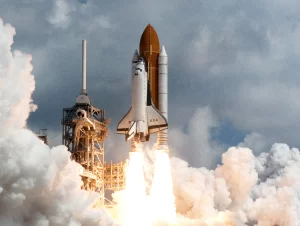Space To Contemplate

My grandmother, Tina, was a young woman when she travelled with her family to California to visit relatives. It was her first trip to the West Coast. The second day there everybody hopped aboard the car to take in the ocean.
When they arrived at the beach, Tina walked down the sand to the edge of the water and looked out to sea for a long while. Then she turned to her cousin and said, “I thought it would be bigger.”
I had the same reaction when the first image of the James E. Webb telescope was unveiled. The scale of the universe causes the mind to skip a beat or two in trying to contemplate it, even when dazzling visual images like these are presented. There’s something metaphorical in viewing infinity on a screen of limited size. One’s mind is the screen.

Of course much of what you’re shown is a beautifully photoshopped version of what the telescope records. Do we need to be reminded there are no colors in space? The vivid hues we see are the artist’s representation of infrared light.
Nevertheless it’s quite an instrument and yet another reminder that the most bang we get for the NASA buck comes from non-crewed missions. Anything the space agency does that involves a human crew costs orders of magnitude more per mission. The safety of the crew is a paramount consideration, after all, and safety is expensive.
In the long ago days of male-gender-default pronouns, James Michener in his book Space decreed, “Man is the measure of all things.” At NASA, that came to mean the fickle public would only support its $multi-billion budget if there were astronauts to identify with and cheer on.

Hence, in the post Cold War environment, when the Soviet Union no longer provided a raison d’être, preposterously expensive and scientifically banal programs like the International Space Station and the Space Shuttle launch vehicle flew for no other reason than to have a place where astronauts could be sent and an extravagant way to get them there. One trillion dollars later, there is virtually nothing of value to show for it except the pensions of all the astronauts who’ve managed to lounge there for a few months over the past two dozen years. (HERE) and (HERE)
Among many questionable things I’ve done in my somewhat sordid past is time in the Nineties I spent running an aerospace organization. We represented many of the nation’s governors in dialogue with the federal government about policy matters that affected the states’ aerospace interests.

That meant spending a fair amount of time and effort dealing with NASA. It was illuminating, if no clearer than those images from space before the artists buff them up. I learned a lot about how bureaucracies work and don’t work, often not efficiently and sometimes not at all. One thing they all do with determined enthusiasm and skill honed from repeated practice is conspire to increase the annual agency budget.
NASA is a discretionary account, among the forty percent part of the federal budget that is not mandated by law. Like defense, transportation, and a host of other discretionary programs that are funded annually by Congress through the authorization and appropriations process, NASA spends very substantial time and energy scheming to preserve and expand its budget. It’s not by chance that its field centers, contracts, and granting programs are scattered widely through key Congressional districts and states. Easier to push those levers when a lot of hands are in the till.
Because of the Michener mantra, much of the game plan ends up with various contrived rationales for sending humans to space. Often those proposals are brightly wrapped in the extraordinary – even other worldly – science benefits that humanity will accrue. The truth though is that NASA has precious little credibility in the scientific community beyond astronomy.

That’s because the Agency at its heart is engineers, folks who like to bend metal and build hardware. Science if any is a toupee on a very bald lie, at least where human spaceflight is concerned. When that hardware is robotics, the astronomy science can be fabulous.
Witness the Mars Rovers, the Pioneer Mission, all the various robotic probes, the Hubble Space Telescope, and now the James E. Webb telescope, which already is expanding our knowledge of the origins of the universe if not infinitely at least geometrically. These missions are relatively cheap and yield much more value.
Now our astronauts are going back to the moon. As a stepping stone to a flight to Mars. No doubt we’ll need even more of those brave space jockeys to get it done. More ways, too, to subsidize Elon Musk’s “commercialization” of space.
I’ve been hearing since the Nineties this is human evolution. “We are meant to explore. It’s our nature.” The measure of all things.
What it is, really, is something for the astronauts to do. We got ’em, we need ’em, let’s do something with ’em. Convoluted thinking often is the fruit of the poisoned tree. Benefit to humanity, and not Man, should be the measure of all things publicly financed. More Webb, please, and less Michener.